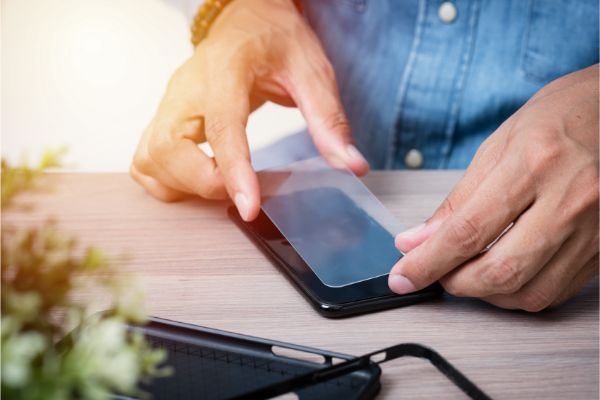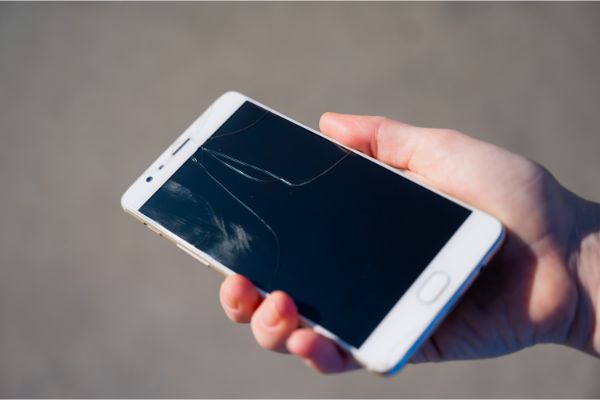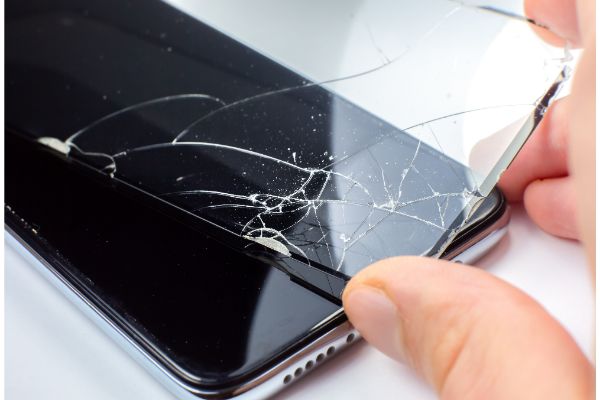Disclaimer: This post may contain affiliate links, meaning we get a small commission if you make a purchase through our links, at no cost to you. For more information, please visit our Disclaimer Page.
The front screen of your smartphone is how you can view the content you want to access, but it is also the primary way in which you’ll interact with the device itself. As such, the screen is one of the most crucial parts that will go into any modern phone design. Typically, manufacturers making glass for phone screens will use chemical processes to make that material very hard.
They do this as a way to help the screen resist any possible damage it might take from drops, impacts, or general use. Although most of these glass panes are effective at keeping the screen in good condition when a person uses their smartphone normally, scratches or cracks can still appear along the surface of any phone. This sort of problem could come about due to misuse, accidents, or defects during the manufacturing process.
Whatever the case, some phone owners might want to know what they can do about screens that already show such wear and tear. Screen protectors are common accessories that many people purchase, but the developers of these accessories usually market them as things that might offer an extra layer of damage prevention.
Today, we will discuss whether it is fine to put such a protector on a screen that already has a crack in it. Along the way, we will talk about hiding or stopping cracks, explore some possible signs that it is time to swap out your protector, and what you should do if this layer itself shows a scratch.
Table of Contents
Is It Okay To Put a Screen Protector on a Scratched Screen?
Yes, it should be fine to put a protector on a phone screen with a scratch on its surface.
Phone protectors like this are supposed to help the screen avoid cracks in the first place, but a later application of one may help to guard the device against further damage.
Because of the way in which manufacturers make phone screen protectors, they should not have any elements that worsen the problems with a phone screen.
If there is any defect in the product during its manufacturing phase, it is possible that the protector could do something else to the cracks that you already see. However, any such accessory from a reputable brand should hold up well.
Before we move on to other topics that might relate to dealing with scratches, it is a good idea to add that protectors such as these don’t repair the cracks in the screen.
You may be able to find products that can help you buff out or otherwise lessen the severity of a cracked phone screen. However, a protector’s primary purpose is to try to prevent cracks from forming.
There is still some value in putting a covering like this over any screen that shows signs of this kind of damage, and it may keep the phone in a usable state for much longer.
Will a Screen Protector Hide Cracks?
It may be possible for a screen protector to hide cracks. That said, the type of screen protector you choose may play some role in how well the accessory disguises cracks in your screen.
The placement and severity of the scratches themselves will also be factors that can determine if a screen protector can do a job like this.
Some protective layers are light, and they use film-like substances to cling to the touchscreen of a smartphone without adding much bulk to its front panel. Other protectors are much heavier in comparison.
You might choose an accessory of the latter type if you want a thick protector that can take its own deep scratches when you drop or strike the phone.
These kinds of shields might lessen the presence of scratches, but they are also a good way to protect the front panel from developing more issues. While it is unlikely, even your normal use of the phone’s screen could worsen its cracks.
This is something you might want to look out for, especially if you find that your phone’s front panel has any long, deep scratches that run along its length.
Tempered glass tends to be thick, and it may be able to hide the fact that your phone is sporting some scratches. To do this most effectively, the scratches would need to be tiny and shallow.
The thickness of the glass layer might be able to shield cracks like these from your general view, particularly when you are looking at the screen from certain angles.
Should the scratches be wide or deep, however, you’ll probably still be able to see them underneath the pane of glass.
Will a Screen Protector Stop a Crack From Spreading?
A solid screen protector may help to stop a crack from getting larger. In particular, you might go for liquid glass protectors that add several levels of hardness to the front panel of your smartphone.
By doing so, you might be able to prevent a crack from growing.
If you do have a scratch on your screen, you may want to put some kind of protector over it immediately.
Depending on how deep or severe it is, a crack in the screen could spiral out and spread to other areas of the front panel. Even using your phone normally with your fingers could cause further damage to it in this state.
Although you will still need to apply pressure with your finger in order to get the phone to access its touch membrane through the protector, this secondary layer should help to distribute some of the pressure away from the screen.
Furthermore, the protective layer should be the first one to take any additional damage from various impacts to the front of the phone. With these things in mind, an accessory like this should stop a crack from getting worse.
What Are Some Signs That I Need To Change My Screen Protector?
Just like the screen itself, it is possible that you will need to swap out the protector at some point. There is no hard rule for when to do this.
However, there might be some signs we can use to troubleshoot the issue and get a good idea of when to replace this part of the phone.
1. You should be able to feel any damage to the screen protector. This is a layer that sits over the phone’s screen, and it should feel smooth if it does not have any damage
. If you can feel rough parts to any area of the protective layer, it may be time to change the accessory for a new one.
2. If you see any severe fissures in the top layer, swapping out one screen protector for another may be a good opportunity. Long or large cracks that dig into the surface of the protector indicate how well it absorbed an impact.
If you did not have a screen protector on your phone then, the device itself would have taken all that damage. Such harsh impacts could have rendered your phone inoperable, but the screen protector saved it.
Nevertheless, the damage has compromised the layer’s integrity, and you should seek a replacement as soon as possible.
3. If you have difficulty viewing content through the old protector, it is a good time to get a new one. Blemishes, scratches, or deep cracks can all affect the quality of the images you view on your phone.
If there are so many issues with the screen protector that you cannot enjoy your phone’s primary viewer, it is time to look into getting a replacement pane or film.
4. If pieces of the protector are coming off the surface, you should replace them. This can be doubly important for the overall safety of the screen itself.
If you already saw cracks in the screen before you installed the protector, a faulty barrier could start taking pieces of the screen with it.
The protector might also widen any scratches on the screen’s surface when it starts to fail this way.
5. Even if the screen protector isn’t falling apart, it might lose its adhesiveness. There are things you might be able to do in order to restore some of the sticky layer here.
However, it might be easier just to replace the protector altogether.
Do I Have To Replace My Screen Protector if It’s Cracked?
It might be a good idea to replace a screen protector with a crack. However, some of the solution to this dilemma will be up to each user’s personal preference.
A screen protector with a crack in it means that at least some of the shield’s integrity is now weaker than it was when it was new.
Any kind of crack or scratch on the surface of the protective layer could lead to further cracks later, and they might appear more easily than the first one did.
If the protector has a few very small, shallow scratches along its surface, it is possible that it is still strong enough to absorb some harsh impacts that could otherwise damage the phone.
If you think this is the case, replacing the layer may not be necessary yet.
As long as small cracks do not interfere with your ability to see images or texts on the screen, a protector in this state may last longer.
Any layers that have severe cracks are falling apart, or cannot stay on the surface of the phone’s frame are ones that you should replace as soon as possible.
Before getting a replacement protector, you should consider the state of the phone’s screen. If the screen is fine, you should be okay to replace the protective shield whenever you want.
However, this could be problematic if your screen has already taken some damage.
Should your smartphone screen have noticeable cracks, taking off a broken protector could break the screen and pull pieces off it. I
n such situations, you should only purchase a new screen protector when you are ready to repair or replace the underlying screen simultaneously.
Conclusion
Most smartphone screen protectors are basic panes that can offer good protection at low costs to the end user. As long as you buy screen shields of relatively good quality from reputable brands, you should be able to assure yourself that your phone has another layer of impact protection.
Even a screen protector with small scratches can still be useful, and it can work to hide some of the cracks in your phone’s screen.
If an impact damages your protector too severely, consider replacing it to keep giving your phone some extra security.



